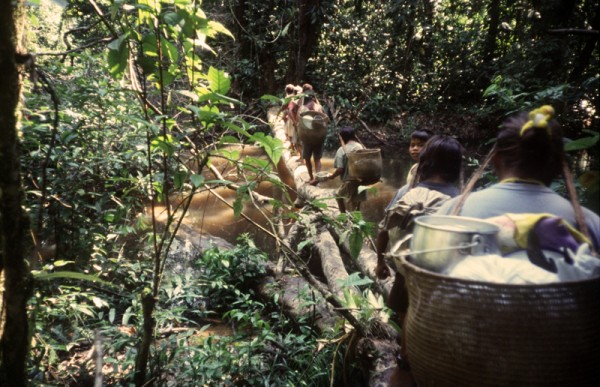| Bilingual Education: What It Is, and Why and How It Works (or Doesn’t) | Morphology: How are words formed? |
 By Patience Epps
By Patience Epps
Associate Professor of Linguistics, University of Texas at Austin
[Editor's Note: This month sees the first part of The Path to Pij Dëh, a four part series by Professor Patience Epps, recounting her experiences with the Hup people of the northwest Amazon.]
We sat close together around a fire in the chilly pre-dawn, small children huddling against their mothers. The Hupd’äh women spoke to each other in low voices. A few young boys still lay wrapped half-asleep like cocoons in their hammocks, slung between small trees. It was not yet light, and in the gaps between the leaves in the forest canopy overhead a few stars were visible. The air was very still. Only the drowsy movements of the boys in the hammocks stirred the trees slightly and rustled the leaves over our heads.
The women were listening for something, looking out away from the fire and into the darkness of the forest. Grandmother Paulina looked over at me. “Wï’ïy am?” she asked, “Do you hear it? Wähädd’äh, the Old Ones.” “It’s the Yurupari,” Teresa, the young schoolteacher, whispered to me.
I had heard nothing yet, but now when I listened into the darkness I could make out a low, pulsing rhythm, coming from far away through the forest. Teresa moved closer to the fire. “It makes me afraid,” she said. “I don’t want to see it. I don’t want to die because of that Yurupari!” Our little group of women and children sat close together, listening to the deep pulse of the horns out somewhere in the forest in the direction we had come.
Our journey had begun two days before, when we left Tat Dëh and set out on the path to Pij Dëh. I myself had arrived at the Hupd’äh village of Tat Dëh, or Taracuá Igarapé (as non-Hupd’äh call it), only a few weeks earlier. I was planning to spend a year among the Hupd’äh of the Tiquié River to study their language. Even though I had yet to make much progress in understanding what was said to me in Hup, I quickly learned that plans for a dabacuri, or ritual presentation and party, had been afoot for some time. Most of the adults and many of the children among the village’s eighty or so current residents intended to make the trip to Pij Dëh, or Cabari do Santa Cruz, a village on the Japu River some twenty-five kilometers through the forest. Days before the event, a group of men and women from the village had set out to collect the fruits of the buriti palm (Mauritia flexuosa), which they had left in the forest near the buriti trees, in the general direction of Pij Dëh. This fruit would later be presented to the residents of Pij Dëh in the ritual context of the dabacuri, followed by dancing and the drinking of caxiri, or manioc beer, that accompanies every party in the region.
Everyone was talking about the trip, and the party that would follow. “W’ëh, w’ëh! B’ok pög! It’s far, and lots of mud to walk through!” I was warned by old Dabina, Paulina’s mother and the great-grandmother of many of the village children. Non-Indian women, I gathered, were not expected to be able to make such a trek through the forest. But Teresa, the Hup schoolteacher who spoke Portuguese, assured me that no one would object to my presence, as long as I could keep up.
The Hupd’äh are people of the forest, and for those who are not old or infirm, periods of time spent in the jungle, far from the village and the manioc fields, are a welcome diversion. “It’s nice there,” Teresa said to me, “calmer.” So several families with young children left a day early, walking slowly and stopping frequently to take advantage of whatever game, fish, or forest fruits were available. Men walked ahead with machetes, and women carried their baskets laden with hammocks, metal pots, cakes of manioc flatbread, and supplies of dry manioc meal suspended from their heads and across their backs with straps of envira bark, leaving their hands free. Babies were carried in bark or cloth straps, and small children were led by the hand or would be slung up on their mother’s shoulders behind a basket from time to time when they got tired.
The rest of the families left the next day, setting off in small groups. A few women who had several young children stayed behind, and their men set out later, walking fast and quickly overtaking the slower women and children. I set out in the late morning with Americo, the Hup ‘capitão’ or village leader, and the schoolteacher Rosalino, a man from a neighboring Tukano group (linguistically and culturally distinct from the Hupd’äh) who had married a Hup woman and now lived in the community. The path led for nearly an hour through the sun-baked manioc fields and brushy capoeira, or old overgrown fields, until finally we left the village sphere fully behind and entered the deep, unbroken forest. The shade of the trees was welcome after the burning sun of the open fields, but the air was humid and close, and did not seem much cooler. The ‘bird of thunder’, the red-throated caracara, shrieked over our heads from time to time, and when we paused the mosquitoes and the biting flies with their angry buzzing would close in on us.
 It had rained recently, and in places the path was wet and muddy. Once Americo, walking ahead of me, stepped into a deep patch of mud and we had to pause and wait for him to dig out his flip-flop sandal, which had stuck in deep. In a few places the path traversed a swampy area, where the black mud was spotted with dead leaves and broken here and there by broad-leafed plants rising out of thick clumps of roots. The path here had been improved some time before with sticks laid end to end through the mud, so we balanced across the narrow, mud-slick poles, catching the trees and branches beside us for balance. When we came to streams, the path usually found a crossing on some fallen tree, sometimes a natural deadfall, sometimes felled by other travelers. Many of these were narrow and slick from the rain and humidity, and at times it was a challenge to keep our footing as we crossed, especially in slippery flip-flop sandals and with the extra burden of baskets and small children, and for me with my rucksack. Occasionally a log-bridge had been provided with a hand-hold somewhere near the middle, usually a long pole stuck into the mud of the streambed below and left sticking up vertically next to the log crossing. Nevertheless, despite the occasional warning calls of “yib hõ! It’s slippery!” to those coming after, the Hupd’äh had little difficulty. I came close to falling several times, until finally I took off my sandals and went barefoot, like many of my companions, and found it easier to keep my footing without an extra layer of slippery rubber between my feet and the logs.
It had rained recently, and in places the path was wet and muddy. Once Americo, walking ahead of me, stepped into a deep patch of mud and we had to pause and wait for him to dig out his flip-flop sandal, which had stuck in deep. In a few places the path traversed a swampy area, where the black mud was spotted with dead leaves and broken here and there by broad-leafed plants rising out of thick clumps of roots. The path here had been improved some time before with sticks laid end to end through the mud, so we balanced across the narrow, mud-slick poles, catching the trees and branches beside us for balance. When we came to streams, the path usually found a crossing on some fallen tree, sometimes a natural deadfall, sometimes felled by other travelers. Many of these were narrow and slick from the rain and humidity, and at times it was a challenge to keep our footing as we crossed, especially in slippery flip-flop sandals and with the extra burden of baskets and small children, and for me with my rucksack. Occasionally a log-bridge had been provided with a hand-hold somewhere near the middle, usually a long pole stuck into the mud of the streambed below and left sticking up vertically next to the log crossing. Nevertheless, despite the occasional warning calls of “yib hõ! It’s slippery!” to those coming after, the Hupd’äh had little difficulty. I came close to falling several times, until finally I took off my sandals and went barefoot, like many of my companions, and found it easier to keep my footing without an extra layer of slippery rubber between my feet and the logs.
After a few hours of walking we came across a little tapiri, or palm-leaf shelter, built not far from the path. One of the families with several small children that had left the day before was lounging comfortably there, their hammocks tied between trees, and several other travelers had gathered there to rest for a few minutes and chat, sitting on broad leaves placed between them and the wet ground. A metal pot full of yellow c’ak dëh, or water mixed with buriti paste and manioc meal, was on the ground, and we all took turns drinking the tasty liquid and the soaked meal with a gourd dipper. Then we set off again.
By mid-afternoon we reached a clearing in the forest, and stopped. Several family groups were already there, having arrived earlier or even the day before, and had built little tapiris for themselves. People lay in hammocks under the narrow palm-leaf roofs, women looked after cooking fires, and a group of children played with a puppy. Americo and Rosalino set about building a tapiri for our little group, and I went with them into the forest to help cut poles. Several children had set up a vine swing in the trees near the edge of the clearing. They had built a rickety little step from sticks lashed together with cipó vines for a jumping-off point, and had tied cross-bars to the ends of the vines so that they could sit comfortably as they swung back and forth. They called me to watch as they launched themselves swinging into the air, shrieking with delight.
We gathered together a bundle of long poles and some cipó vines for tying them together, and returned to the clearing. The ends of the poles were sharpened and then driven into the ground, first two vertical poles at each end of the future shelter, connected with a horizontal cross-piece, then two diagonal poles overlapping with these to support a long ridgepole. Some small rafter-sticks were added, and then the men went off into the forest and reappeared with about a dozen huge palm leaves, which were laid lengthwise across the rafters, from end to end of the shelter, to make a water-tight roof. We slung our hammocks in the cramped space under this roof.
I joined Teresa and her mother-in-law Paulina to bathe in the stream nearby, as other small groups of Hupd’äh continued to arrive and set up their own tapiris, until there were seven or eight shelters of varying sizes. Everyone seemed relaxed, glad for a break in the daily routine and the prospect of a party and a visit with friends and relatives in Pij Dëh. Before dusk fell the group ate together, a communal meal of manioc flatbread and spicy mojeca, or fish stew. The bowls were placed on the ground in the middle of the group of tapiris, and first the men ate, then the women. As it began to grow dark many of the men set off into the forest with fishing poles, flashlights, bows and arrows, and one shotgun. Dusk is a good time for hunting and fishing, and the prospect of success is much greater in the relatively unexploited forest away from the village.
Other men took advantage of the last light to weave disposable baskets, which they would use for carrying the buriti fruit to Pij Dëh. These were of two types, one made from a single palm leaf, folded in half, with its fronds woven together and brought around to form a closed circle, then braided up in a seam opposite the central stalk of the leaf. The other was built of slats cut from the stalk of the palm leaf, arranged one next to the other to form a cylinder, and bound together with cipó vines. A network of woven cipó was also used to form the base of the cylindrical basket. These disposable basket weaving tasks fell uniquely to the men, but many women had brought along their own basket projects, the more permanent ‘atura’ baskets whose weaving is exclusively the domain of women. As dusk fell, people sat around the tapiris on the ground or in their hammocks, weaving baskets, grooming each other’s hair, and chatting…
To be continued next month…

 eNewsletter
eNewsletter